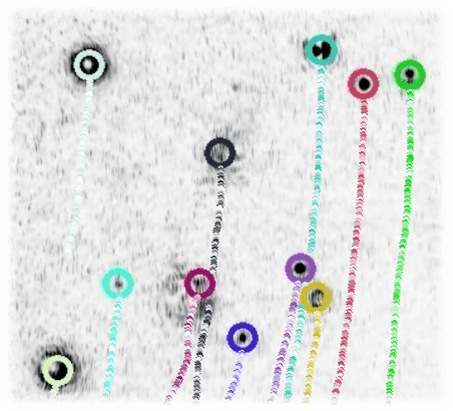
We use the tools of nanotechnology and develop a visual tracking algorithm for motion analysis of nanoplatforms under the influence of an external magnetic field. We have studied quantitative relationships between nanoplatform sizes, fluid flow rate and viscosity, external magnetic field strength and their effects on the nanoplatform trajectories.
With the developed tools, we have explored the nanostructures in fluids mimicking the viscosity of the bloodstream. We have developed an algorithm that automatically extracts the position of nanoplatforms, velocity distribution, flow direction and the trajectories from the raw video data. In the analysis, we encounter the difficulties of low contrast cluttered frames with frequent disappearance and reappearance of nanoplatforms due to the three-dimensional nature of their trajectories. This work developed a special procedure that overcomes the mentioned obstacles. We have confirmed that the trajectories can be controlled by the magnetic field. The magnetic force is higher than the fluidic force in the perpendicular to the flow direction, except the cases of relatively high viscosities and large flow rates. The dominance of the magnetic force and approximately a constant number of nanoparticles in each conjugate suggest the potential application of the conjugate nanoparticles as drug delivery platforms.
- A. Nakhmani, L. Etgar, A. Tannenbaum, E. Lifshitz, R. Tannenbaum, “Visual Motion Analysis of Nanoplatforms Flow under an External Magnetic Field,” Nanotech 2010 Conference, Anaheim, CA, June 2010.
- L. Etgar, A. Nakhmani, A. Tannenbaum, E. Lifshitz, R. Tannenbaum, “Trajectory Control of PbSe − γ − Fe2O3 Nanoplatforms under Viscous Fluid Flow and an External Magnetic Field,” Nanotechnology, Volume 21, Issue 17, April 2010.
- L. Etgar, A. Nakhmani, A. Tannenbaum, E. Lifshitz, R. Tannenbaum, “Targeting of PbSe−γ − Fe2O3 Nanoplatforms by External Magnetic Field under Viscous Flow Conditions,” Sensor Letters, Volume 8, Issue 3, pp. 383-386, June 2010.
- L. Etgar, A. Nakhmani, A. Tannenbaum, E. Lifshitz, R. Tannenbaum, “Trajectory Control of PbSe − γ − Fe2O3 Nanoplatforms under Viscous Fluid Flow for Active Cell Targeting,” E-MRS Symposium L: Bio & chem sensors and transducers: from materials to systems, Strasbourg, France, June 2009.
- L. Etgar, A. Nakhmani, A. Tannenbaum, E. Lifshitz, R. Tannenbaum, “Trajectory Control of PbSe − γ − Fe2O3 Nanoplatforms under Viscous Fluid Flow for Active Cell Targeting,” Symposium U: Electrofluidic Materials and Applications – Micro/Biofluidics, Electrowetting, and Electrospinning, San Francisco, CA, April 2009.
- L. Etgar, A. Nakhmani, A. Tannenbaum, E. Lifshitz, R. Tannenbaum, “The Behavior of PbSe − Fe2O3 Conjugate Nanostructures under Flow Conditions,” International Workshop on Optical Properties of Coupled Semiconductor and Metallic Nanoparticles, Max Planck Institute for the Physics of Complex Systems, Dresden, Germany, July 2008.

Published by